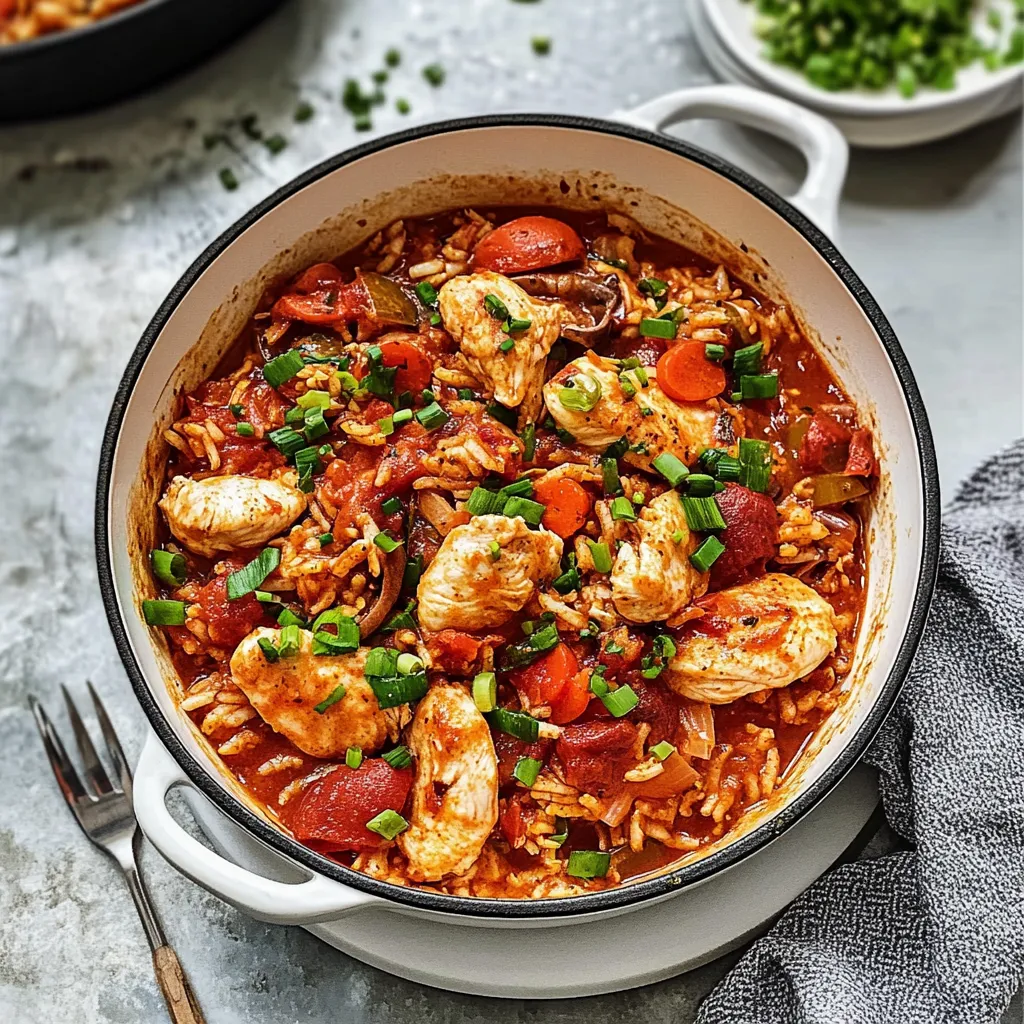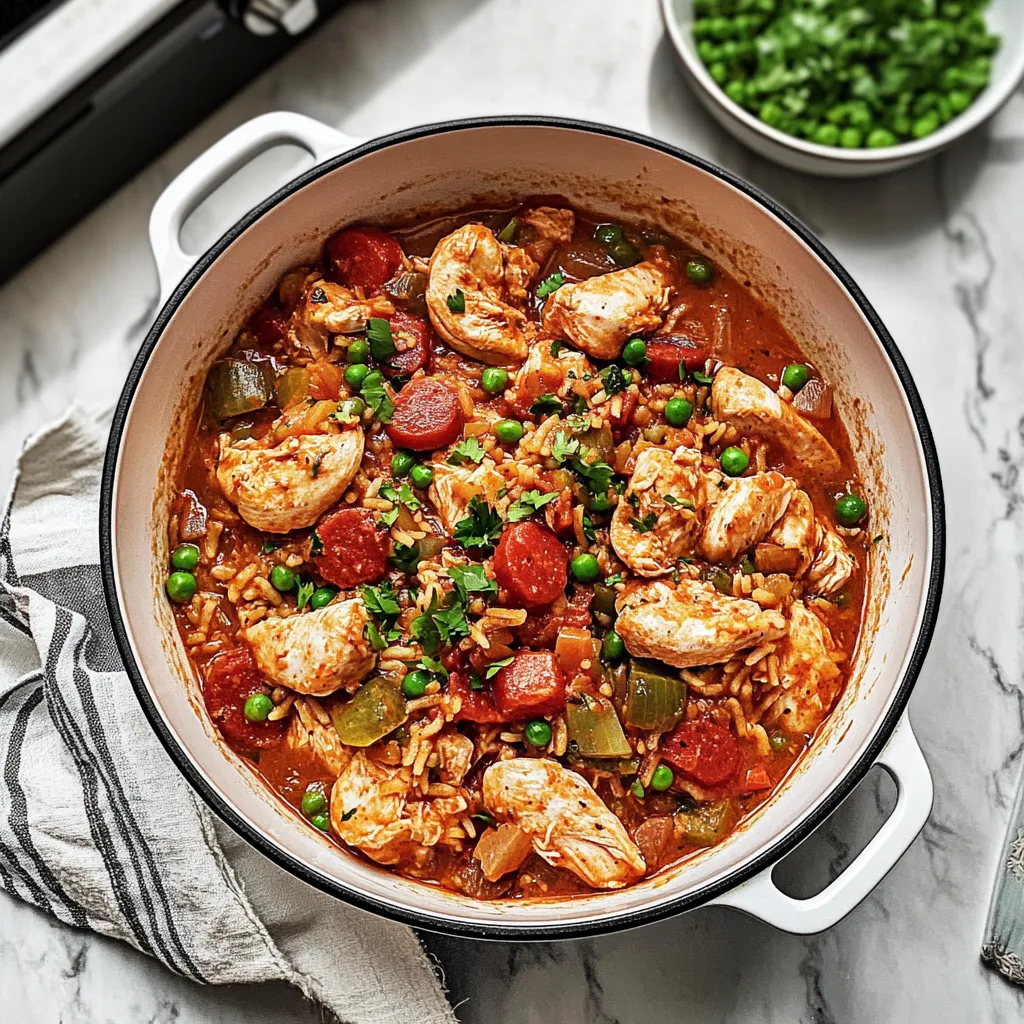Jambalaya: A Classic Cajun Recipe to Spice Up Your Dinner

Nothing evokes the soulful essence of Louisiana quite like a warm bowl of Jambalaya. This vibrant dish, brimming with a medley of flavors and textures, is a delightful fusion of Cajun and Creole culinary traditions. Whether you prefer a classic rendition with chicken and sausage or a seafood-infused variation loaded with shrimp and crab, the beauty of this dish lies in its versatility. Each bite transports you to the bustling streets of New Orleans, where every ingredient tells its own story.
For those looking to elevate their cooking game, there are some expert tips to ensure your creation is nothing short of spectacular. Using high-quality broth, allowing the rice to absorb all the rich spices, and incorporating fresh ingredients makes a world of difference. Additionally, timing is crucial; letting it sit for a few minutes before serving allows the flavors to meld beautifully. So, roll up your sleeves, gather your ingredients, and get ready to embark on a culinary adventure that promises to tantalize your taste buds.
Ingredients for Jambalaya:
This classic dish combines a variety of ingredients, providing a delicious medley of flavors. Below is a detailed list of everything you will need to make Jambalaya for 8-10 servings:
Proteins:
- 1 pound Andouille sausage, sliced
- 1 pound boneless, skinless chicken thighs, cut into bite-sized pieces
- 1 pound medium shrimp, peeled and deveined
Vegetables:
- 1 medium onion, diced
- 1 red bell pepper, diced
- 1 green bell pepper, diced
- 3 stalks of celery, diced
- 4 cloves garlic, minced
Rice and Broth:
- 3 cups long-grain rice, rinsed and drained
- 6 cups chicken broth (preferably low-sodium)
Seasonings and Spices:
- 1 tablespoon Cajun seasoning
- 1 teaspoon dried thyme
- 1 bay leaf
- ½ teaspoon cayenne pepper (adjust to taste)
- Salt and black pepper to taste
Additional Ingredients:
- 1 can (14.5 ounces) diced tomatoes, undrained
- 1 cup frozen peas
- ¼ cup chopped fresh parsley (for garnish)
- 2 tablespoons olive oil (for cooking)
Variations and Alternative Ingredients:
For those looking to customize their Jambalaya, consider these variations:
- Swap Andouille sausage for smoked sausage or kielbasa for a different flavor profile.
- Incorporate fish like catfish or tilapia for a seafood twist.
- Add okra for a more traditional touch, which also adds vibrant texture.
- For a vegetarian version, replace meat with plant-based proteins such as tempeh and use vegetable broth.
Feel free to get creative with your seasoning choices! Experimenting with different spices or fresh herbs can elevate this dish and showcase your culinary style.

How to prepare Jambalaya:
To make a delicious Jambalaya, follow these simple steps to ensure a flavorful and well-cooked dish.
Gather Your Ingredients
Start by gathering all the necessary ingredients for your Jambalaya. You will need 1 pound of boneless chicken thighs, 1 pound of shrimp, 1 onion, and 1 bell pepper. Also, have 2 cups of long-grain rice, 4 cups of chicken broth, 3 cloves of garlic, 1 can of diced tomatoes, and your preferred spices like cayenne pepper, thyme, and bay leaves.
Prepare the Chicken
Begin by cutting the chicken thighs into bite-sized pieces. Season the chicken with salt and pepper. This adds initial flavor that permeates the cooking process.
Sear the Chicken
Heat 2 tablespoons of olive oil in a large pot over medium-high heat. Once hot, add the chicken pieces and cook until they are golden brown, about 5-7 minutes. Remove the chicken from the pot and set aside.
Sauté the Vegetables
In the same pot, add diced onion and bell pepper. Sauté the vegetables until they are soft, approximately 4-5 minutes. Add minced garlic and cook for another minute until fragrant.
Add Spices and Rice
Stir in your spices, including a teaspoon of cayenne pepper and 1 teaspoon of dried thyme. Combine them with the sautéed vegetables for an even distribution of flavor.
Next, add the rice to the pot. Stir it well to coat the grains with the flavorful vegetable mixture.
Pour in Liquids
Add the can of diced tomatoes (including the liquid) and the chicken broth. Scrape the bottom of the pot to incorporate all flavorful bits stuck to the base.
Combine Everything
Return the seared chicken to the pot and bring the mixture to a boil. Once boiling, reduce heat to low and cover the pot with a lid. Allow it to simmer for about 20-25 minutes, or until the rice is cooked and has absorbed the liquids.
Add the Shrimp
After the rice is tender, gently fold in the shrimp. Cover the pot again and cook for an additional 5 minutes, or until the shrimp are pink and cooked through.
Serve Your Dish
Once finished, remove the pot from heat. Let Jambalaya rest for a few minutes before serving. Serve hot, garnished with chopped parsley or green onions for an extra burst of flavor.
Tips for the Perfect Jambalaya
Maintain the Right Temperature
To achieve a delicious dish, mastering your cooking temperature is crucial. Start by heating your pot over medium heat before adding oil. This warming allows your ingredients to sizzle immediately, sealing in flavors. Once your protein hits the pot, don’t rush it. Allow it to brown thoroughly, which adds depth to the dish.
Once you combine the rice and broth, bring the mixture to a full boil. Then lower the heat to a simmer. A gentle simmer allows the rice to absorb liquid without becoming mushy. Cover the pot tightly to lock in steam, which helps the grains cook evenly. Stir only briefly to prevent sticking, as too much stirring disrupts the cooking process.
Quality Ingredients Make a Difference
Using quality ingredients can transform your meal. Start with fresh vegetables—onions, bell peppers, and celery are classic choices. Opt for those that are firm and brightly colored. For proteins, if you choose sausage, look for smoked varieties with rich spices. Fresh seafood can also elevate your dish; shrimp and fish should smell fresh and not overly fishy.
Don’t skimp on spices; they form the heart of the flavor. Use a combination of paprika, cayenne, and thyme for the best results. Lastly, consider high-quality broth or stock rather than water. Opt for low-sodium varieties if sodium content is a concern, allowing you to control flavor better.
Dietary Substitutions
Accommodating dietary restrictions can be simple. For a vegetarian version, skip the meat and sausage. Replace them with hearty vegetables like mushrooms or zucchini and add beans for protein. Use vegetable broth instead of chicken or seafood stock for a rich taste.
If you’re gluten-free, ensure your sausage is gluten-free and use rice labeled as such. Quinoa is another great alternative that adds a nutty flavor and is gluten-free. For a lighter option, cauliflower rice works well, though cooking times will vary, so adjust accordingly.
Final Thoughts
The key to delicious fare lies in attention to detail. From temperature control to choosing optimal ingredients and making smart substitutions, each step contributes to a flavorful outcome. Keep experimenting with different flavors and textures to find your perfect blend!
Storage Tips for Jambalaya:
Maintaining the freshness of your cooked dish is essential for both flavor and food safety. Proper storage practices ensure that leftover jambalaya remains delicious and safe to eat. Below are practical tips on how to store this dish effectively.
Cooling Your Jambalaya
Before storing, allow the jambalaya to cool to room temperature. Avoid leaving it out for more than two hours to prevent bacterial growth. Divide larger portions into smaller ones to speed up the cooling process. You can use shallow containers for quicker cooling. This step helps preserve taste and texture when you reheat it later.
Optimal Storage Conditions
Transfer the cooled jambalaya to airtight containers. Use quality containers that seal well to prevent air from entering. This keeps moisture in and odors out, preserving the dish’s flavor. You may also use resealable plastic bags if you prefer. Ensure you press out any excess air for best results. Label each container with the date of storage for easy reference.
Refrigeration Tips for Jambalaya
Store your jambalaya in the refrigerator if you plan to eat leftovers within three to four days. Make sure your refrigerator is set to 40°F (4°C) or lower. Keeping it at the proper temperature slows down the growth of harmful bacteria.
Freezing for Longer Shelf Life
If you want to keep it longer, consider freezing your jambalaya. It can last up to three months in the freezer. For freezing, use airtight containers or heavy-duty freezer bags. Make sure to leave some space in the container for expansion during freezing. When ready to eat, thaw the dish overnight in the refrigerator before reheating.
Reheating Methods
When reheating, make sure the jambalaya reaches an internal temperature of 165°F (74°C). You can reheat it on the stovetop over low heat, stirring occasionally, or use a microwave-safe dish. Stir well and ensure it’s evenly heated for best flavor.
Following these storage tips helps maintain the quality of your jambalaya for future meals. By using proper techniques, you can enjoy this dish without sacrificing taste or safety.
Related Recipes to Explore
If you enjoy the bold flavors and comforting textures of a classic Creole dish, consider trying these related recipes. Each dish shares harmonious elements with the spirit of jambalaya.
Cajun Chicken and Sausage Gumbo
Gumbo features a rich, hearty broth filled with tender meats and vegetables. Like jambalaya, it boasts a mix of spices that offers a taste of Louisiana cuisine. The slow simmering process allows flavors to deepen, making it a satisfying choice for fans of robust dishes.
Paella
This Spanish rice dish combines meats, seafood, and vegetables in a vibrant saffron-infused base. Both dishes celebrate one-pot cooking, bringing together an array of ingredients for a colorful presentation. The communal aspect of paella also mirrors the shared nature of jambalaya, which is often enjoyed among friends and family.
Red Beans and Rice
This comforting dish provides a simple yet delicious combination of tender beans, smoked sausage, and spices served over rice. Its ease of preparation and complex flavor profile share a kinship with jambalaya, making it a fantastic option for weeknight dinners when time is limited.
Etouffee
Etouffee consists of a flavorful sauce made from a roux, vegetables, and seafood or chicken, served over rice. This dish highlights a similar Southern flair and the use of the “holy trinity” of Cajun cooking: onions, bell peppers, and celery. Both dishes emphasize a robust sauce that enhances the meal’s overall richness.
Each of these recipes captures the spirit and bold flavors of Creole and Cajun cooking, making them wonderful companions to the tastes you love in your favorite rice-based dish.
Frequently Asked Questions:
What is Jambalaya traditionally made of?
Jambalaya is a hearty and vibrant dish that originates from Louisiana, combining influences from Spanish, African, and French cuisines. Traditionally, this one-pot meal is prepared with rice, a variety of proteins such as chicken, smoked sausage, shrimp, and vegetables, particularly the “holy trinity” of bell peppers, celery, and onions. The dish is known for its bold flavors, achieved through seasoning with spices like cayenne, paprika, and thyme.
Can Jambalaya be made in advance?
Yes, this flavorful rice dish can be made ahead of time, making it a great option for meal prep or gatherings. Once cooked, it can be stored in an airtight container and refrigerated for up to three days. When you’re ready to enjoy it again, simply reheat on the stovetop or in the microwave, adding a splash of broth if needed to restore moisture.
Is Jambalaya gluten-free?
Typically, traditional Jambalaya is gluten-free, as it primarily consists of rice and a mix of meat and vegetables. However, if you’re using pre-made sauces or seasonings, it’s essential to check the labels for any gluten-containing ingredients. For a safe option, you can prepare the dish using fresh spices and highly recommended gluten-free broth.
What are some common variations of this dish?
There are many popular variations of this delicious rice dish. The two most notable types are Creole Jambalaya, which includes tomatoes, and Cajun Jambalaya, which does not. Additionally, you can customize the dish further by incorporating different proteins or vegetables based on personal preference or dietary restrictions.
Can I make Jambalaya in a slow cooker?
Absolutely! Preparing this scrumptious meal in a slow cooker is a convenient method that allows the flavors to meld beautifully over time. You just need to add all ingredients, including uncooked rice, and let it cook on low for several hours, stirring occasionally to prevent sticking.
What do you serve with Jambalaya?
To enhance the dining experience, Jambalaya pairs well with a variety of sides. Common accompaniments include a crisp green salad, coleslaw, or even cornbread. For those who enjoy a little heat, a side of hot sauce or pickled vegetables can elevate the meal, making it truly unforgettable.
Conclusion:
Creating a delicious pot of Jambalaya at home is not only simple but also adaptable to your taste preferences and available ingredients. This one-pot wonder showcases the beauty of Southern cooking through its rich flavors and satisfying textures. With easy steps and the flexibility to customize proteins, vegetables, and spices, you can tailor this dish to your liking. Don’t hesitate to experiment with different meats or even plant-based alternatives for a fresh twist. Remember to incorporate the holy trinity of Cajun cooking—onions, bell peppers, and celery—for authentic flavor. Whether you’re hosting a gathering or enjoying a cozy night in, Jambalaya is a perfect choice that brings warmth and joy to any table. Embrace this recipe as your culinary canvas where you can express creativity while enjoying a classic dish!
